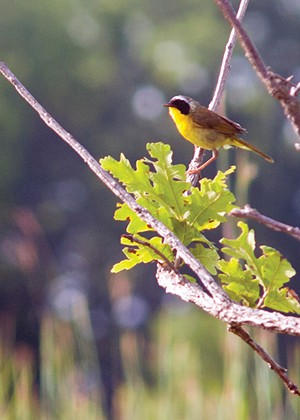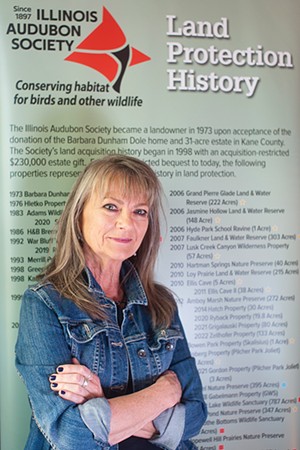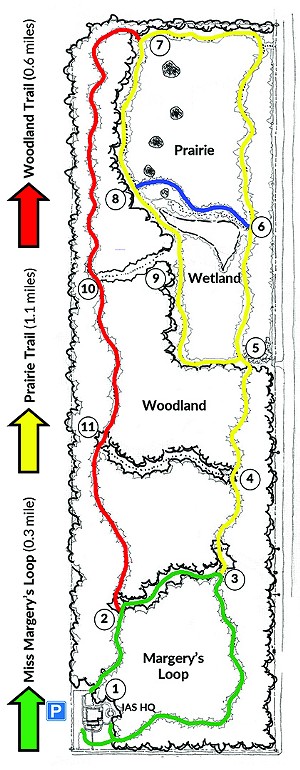
All too often birdwatchers are portrayed as obsessive eccentrics, binoculars glued to their faces, oblivious to the world beyond their lenses. Yet the lengthy history of the Illinois Audubon Society, headquartered in Springfield, reveals a radically different depiction. Are the organization's members obsessive eccentrics? Certainly some. Binoculars glued to their faces? Quite often. But the people who have populated the ranks of the IAS, which is celebrating its 125th anniversary this year as the state's oldest nonprofit conservation group, have shown that not only are they aware of the world beyond their lenses, they are resolute defenders of the ecological communities to which their beloved birds belong.
When three women in Chicago signed the Illinois Audubon Society articles of incorporation in 1897, they and the others standing with them became true conservation pioneers. There were no designated reserves, no protection laws, and few ways to spread knowledge and concern about the loss of birds and their habitats. To put this in perspective, when the Illinois Audubon Society was founded, John Muir had established the Sierra Club a mere five years earlier, a national Audubon society was not in existence, and it would be two decades before the Migratory Bird Treaty Act, one of the oldest wildlife protection laws, would be enacted. Undaunted, these trailblazers began educating adults and youngsters alike about the pressures birds were facing through the limited means available to them – by publishing articles and conducting meetings and school programs.
At the same time, these earliest IAS members helped sponsor and defend some of the first state and federal wildlife protection laws. Scott Weidensaul writes in Of a Feather: A Brief History of American Birding that although the state-level Audubon societies were not alone in pressuring state and federal lawmakers on behalf of birds, "they were crucial, especially on the state level, battling hundreds of bills that would have rolled back or watered down newly enacted safeguards." Decades later, the organization would move from blazing figurative trails, through influencing attitudes about wildlife held by legislators and Illinoisans, to creating physical trails at habitat under its protection.

It is hard to imagine there are 40 acres of woodland, wetland and prairie lying just beyond the Illinois Audubon Society state headquarters, which is situated not far from the tumult of traffic careening down Clear Lake Avenue in Springfield. The staff offices are located at the Adams Wildlife Sanctuary property within the historic Margery Adams house. It is here I meet up with Joanne (Jo) Fessett, who took the helm as IAS's executive director in August, and Matt Hayes, the new assistant to the executive director. Fessett started her work with IAS in 2006, and she is indeed a passionate birder. She is, in fact, depicted in a bio photo with binoculars glued to her face. Yet throughout her time with Illinois Audubon Society and during a tenure with the Nature Conservancy, which coincided with the monumental Emiquon wetland restoration near Havana, Illinois, she has sought to blur the boundaries between the various fields intersecting and sometimes uniting in the pursuit of conservation knowledge – science, ecology and even the arts.
In the 1970s, the organization broadened its vision to include the acquisition of land and acceptance of donated parcels on behalf of wildlife, and the Adams Wildlife Sanctuary is but one of Illinois Audubon's 24 properties. Fessett is quick to clarify that the land protection accomplished by the organization extends beyond the 3,061 acres of land within their preserves. "Our goal is not to amass the most property we can. Our goal is to protect habitat," she states. She explains how IAS is often able to act with greater agility than other organizations when important habitat, such as land adjacent to an existing reserve, becomes available. When notified of another group's interest in a significant parcel, they can often move more quickly, attending auctions and working with landowners to complete a transaction, then holding the land while the interested group awaits the necessary funding – whether it be the Illinois Department of Natural Resources or smaller park and conservation districts. Finally, with no financial profit, IAS transfers the land.

Fessett hands me a list of tracts acquired from 1973 to 2022 that includes not only the organization's designated sanctuaries and preserves but also land acquired and passed to other groups. The Illinois Audubon Society has protected 5,862 Illinois acres that its land committee determined to be of conservation value. "The habitat is the big thing," she states, "but sometimes something stands out." The necessity for protection may be obvious, as with the Plum Island Eagle Sanctuary, a 45-acre island near Starved Rock State Park acquired by the group with the assistance of the Illinois Clean Energy Community Foundation in March 2004, saving it from threatened development and preserving not only a wintering site for eagles but Native American archaeological sites as well.
She further notes, however, that land acquisition decisions are not based solely on the potential benefit to bird species. More recently the "something" that stood out to spur recent purchases of three sites included bat caves, spotted dusky salamanders, and Blanding's turtles, with both the salamanders and turtles designated as state-endangered species. Also coming into the decision-making process, she adds, is whether there is a group nearby the parcel in question that would help steward it.
A group nearby that would help steward it... While reading about the handful of people who acted to form the organization in 1897, I saw the power of volunteers and grassroots movements, the ability of individuals working locally to achieve big wins for conservation. The IAS founders were people who had watched in real time as passenger pigeons were hunted to extinction and as the feathered-hat craze led to the slaughter of millions of birds. They were people who stood up to say, "No more."
Today, members of the 17 local chapters scattered across the state continue to commit their time on behalf of Illinois Audubon Society's mission to protect and educate. It is no small commitment. Whether it be the physically demanding work of habitat restoration performed under the guidance of the land management staff, or the challenges of educating local communities about the necessity for protections and inspiring them to act, the presence of volunteer stewards remains crucial.
Matt Hayes pauses and lifts his face skyward as he listens. We have moved from the headquarters onto the trails of the Adams Wildlife Sanctuary. Tall and soft-spoken, he is silent for a bit before determining that it is indeed a red-shouldered hawk he is hearing and not a blue jay. "Jays can mimic both red-tailed and red-shouldered hawks," he explains. The selection of Hayes as assistant to the executive director speaks to Illinois Audubon Society's continued commitment to the birds. He is a population biologist with advanced degrees earned from his study of sandhill cranes in Wisconsin and the Midwest with the International Crane Foundation. His most recent work is as an educator, teaching ornithology at University of Illinois Springfield.
The winding trails we follow through the woodland surrounding the Springfield state headquarters as we make our way toward the restored prairie habitat are a physical reminder of how the organization has tried, since its inception, to promote knowledge and involvement. Yes, these sanctuaries are established for wildlife – and recent studies show that urban tracts such as the Adams property are even more valuable than initially understood. It is now known that migrating birds may be drawn toward the lights of cities along their pathway, making even small urban stopover areas of greater importance. Yet the hours and hours of volunteer work involved in the ongoing trail maintenance, the invasive species removal, and the restoration of native habitat make this property an accessible sanctuary for people as well.

It is often said that before someone can care about a species, they must first know it. And the ways people are coming to know and care about species at this sanctuary and at others under the Illinois Audubon Society umbrella are numerous – through programs, events and studies. Examples include the Bird Migration and Aquatic Adventures programs developed by the Hickory Hills Chapter at the Bremer Wildlife Sanctuary near Hillsboro and the Bird Detectives program created for third-grade through fifth-grade Springfield students by members of the Springfield Audubon Society, the stewarding chapter of the Adams property.
Advanced education is also underway at Adams with a study being conducted by a University of Illinois Urbana-Champaign student to determine a framework for establishing understory herbaceous plants in restored floodplain forests. At three other IAS sites, there were studies to determine the effects of habitat restoration methods on wildlife populations over time. The reports these studies produced provide not only invaluable scientific information but also a deeper story about the diversity and history of Illinois' habitats, from the northerly Amboy Marsh and Gremel Nature Preserves that once were part of a more than 100,000-acre complex of wetlands in Lee County to the Round Pond Nature Preserve in the southern part of the state, lying within an ancient channel of the Ohio River with swamps, old-growth bald cypress and tupelo gum trees.
Fessett has called their properties "learning labs," but she clearly understands that these habitats have the potential to fulfill a much larger societal role – as places to breathe, to seek refuge from life's pressures, to search for artistic inspiration. "Different people seek out nature for different reasons, from analysis and crunching numbers to reproducing the experiences through brush and language," she states. Yes, we can study reports for critical facts about the promising number of red-headed woodpeckers at Amboy Marsh, about the endangered rusty-patch bumblebee at Gremel, and about the three bird species at Round Pond – the yellow-billed cuckoos, Acadian flycatchers, and blue-gray gnatcatchers – that have an unfortunate presence on the state's "Species in Greatest Conservation Need" list. We can also visit these sites and many of the others to walk, listen, contemplate and create.
Hayes and I circle a portion of the restored prairie, a riot of plants that support such species as grassland birds, bees and butterflies, before heading back into the woodland toward the headquarters. He mentions the fact that many Springfield residents still know little about the Adams Wildlife Sanctuary despite its remarkable urban location, and it is almost as if he is describing the often-unheralded accomplishments of the untold number of volunteers in Illinois Audubon Society's 125-year history and the role the organization has played in habitat protection in Illinois. "It's this little piece that a lot of people don't really have a clue about," he says. "But once you get on the ground, you're like, this is fantastic."
Jeanne Townsend Handy of Springfield holds a master's degree in environmental studies and is a member of the Society of Environmental Journalists. As a freelance writer, she enjoys exploring the science and dedication underlying habitat restoration and protection efforts. Contact her at

